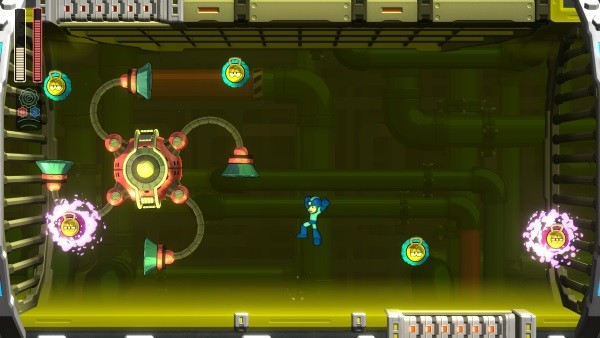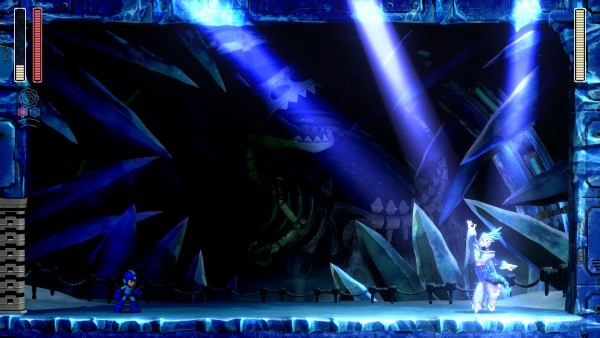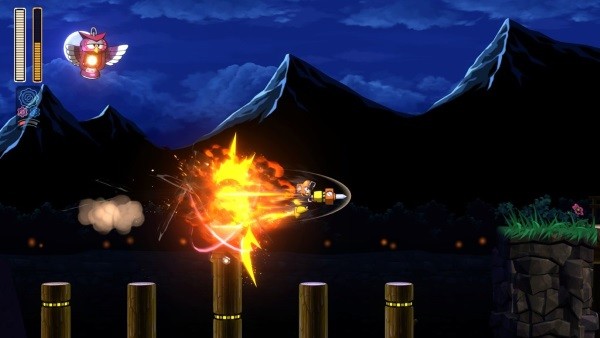Game Review
by Todd Ciolek,Mega Man 11
PS4, Xbox One, PC, Switch
| Description: |  |
||
Fueled by bitter recollections of his rivalry with Dr. Light, the nefarious Dr. Wily revives his Double Gear invention and turns eight of Light's newest robots evil. It's once again up to Mega Man to set things right by defeating these reprogrammed robots and using their weapons against each other. |
|||
| Review: | |||
Don't let the number fool you. This may be the eleventh or twelfth central Mega Man title. It may be backed by several spin-off series. Yet it's been nearly a decade since the last full-blown game in the series. Even then, Mega Man 9 and 10 were deliberate throwbacks, built to resemble the old NES games that made Mega Man such a hit. Mega Man 11 is Capcom's big return to the character, a would-be comeback that lays all cards on the table and does its best to build a classic Mega Man for the modern era. It's a game caught in the middle, balancing a new look and new ideas with a model that hasn't really changed since 1987. And should it really change? Mega Man's basic idea remains superb: take on levels in any order, get a new weapon upon defeating the boss, and experiment with it in other stages. Even so, Mega Man must evolve somehow, and Mega Man 11 pushes things in new directions. For one thing, Mega Man 11 tries to summon a jot of sympathy for longtime antagonist Dr. Wily. In an opening flashback we see him young and angry but not yet a villain—he's just upset that Dr. Light, future creator of Mega Man, shot down his idea and stole his spotlight. The memory inspires present-day Wily to revive that idea, the Double Gear system, and abduct Dr. Light's latest crop of robots. Mega Man sets off to battle these evilly reprogrammed machines, and Light grants him a Double Gear setup of his own.
 Mega Man 11 seems fully into tradition at first. Everything looks polished and is technically 3-D, but our hero leaps and shoots through stages in typical 2-D side-scrolling fashion. The Double Gear hatches two new concepts, however: the Speed Gear slows down everything, ala Viewtiful Joe, to give players more time in tight spots, while the Power Gear grants Mega Man extra-destructive weapons. Neither gear's effects last for long, though, and turning on both at once leaves Mega Man briefly vulnerable. Both gears are helpful in navigating levels, particularly when the game whips rapid projectiles your way, but they're not essential to making it through Dr. Wily's hordes. The real change in Mega Man 11 is subtler: it's toughened up a lot. The eight robot masters' levels are all longer than those of prior games, with a good distance in between checkpoints. And they're much more challenging. Enemies are cunning in their positions and attacks, Mega Man takes damage easily, and instant death often arises from bottomless pits or more vicious hazards. Robo-dog Rush is on hand as a springboard and a jet, but his energy depletes fast. Mega Man games always rewarded memorizing attacks and having the reflexes to evade them, but it's acutely demanding this time around, as though Mega Man 11 styled itself less on side-scrollers and more on bullet-dodging shooters with no mercy for errors.
 Players may feel forced to use the Power or Speed Gears, but Mega Man 11 is more intent on pushing them to a lab run by Dr. Light, Roll, and Auto. Such a shop appeared in some previous Mega Man games, but here it's almost essential to getting anywhere. The longer levels seem too much to survive with Mega Man's default three lives, so you'd better buy more from Dr. Light. The same goes for damage-lessening parts, items that auto-charge your stock Mega Buster, and, of course, energy tanks that completely refill Mega Man's life meter. The E-tanks were a tricky part of Mega Man titles ever since the third game let you stock a bunch, and here they're the player's biggest decision in the game: do you fill up on energy tanks and lives, which is easily done given the game's generous supply of bolts from defeated enemies? Or do you ignore these extras, play cautiously, and die over and over until you get it right?
 It helps that Mega Man 11's stages are worth the trouble. The expanded levels allow the designers to experiment, and each has at least one large and challenging mid-boss. It's all a mix of old ideas with new ones. Acid Man's stage has underwater physics and familiar profusions of spikes, but it throws in a dizzying whirlpool sub-boss and foes whose projectiles gradually turn water toxic. Bounce Man's level recalls both Clown Man and Spring Man, but its candy-colored rubber rooms are a lot of fun to navigate until the bottomless pits appear. And then there's Torch Man's level, which has some delightful background gags (with Mets on a camping trip) but launches into a giant flashfire race that might be the nastiest trick the series has pulled since Quick Man's lasers in Mega Man 2. These levels show off many mechanized enemies, though Mega Man 11 also falls into the series' bad habit of overusing the least interesting foes. You'll occasionally see certain highly creative robots like a cookpot tank piloted by a mecha-potato, but there's no end to the mid-air flower bombs that stay invisible and invincible until you're near. The game also loves to bring out Gabyoall, the spiky, ground-hugging sentries that were irritating and ubiquitous even in the original Mega Man.
 At times the game's difficulty seems unintentional, particularly in the boss battles. The robot masters of Mega Man 11 play dirtier than their predecessors—they'll often switch to new Gear attacks or change form halfway through the battle, and some are tough even when you know their weaknesses. The problem comes from the game bombarding the screen with effects. Mega Man 11 looks nice enough in its “2.5-D” style, but sometimes it's hard to tell just what can damage you in a blur of crackling electricity or bursting flame. Mega Man's clashes with robot masters can be the most memorable moments in any piece of the series, and here the battles are inventive, fast-paced, and…confusing. Some boss fights feel cramped when confined to a single screen, and by their nature the game's polygon graphics are never as simple and precise as old NES games. Even so, the bosses reward the player. Each weapon you'll receive is useful and ripe for experimentation. No mere straightforward projectiles, Mega Man's weapons now change his appearance and maneuvers on-screen, and each has a secondary form granted by the Power Gear or Speed Gear. Switching weapons forces you to consider just how, for example, the Pile Driver hurls Mega Man forward, or how the Acid Barrier won't let you fire shots until it forms protective shields. For their part, the bosses are well-designed, from Blast Man's explosion hairstyle to Tundra Man's Frozen ponytail to Block Man's resemblance to Vincent from The Black Hole. I can't be the only one who sees that.
 The challenging, lengthy original eight stages almost make up for a lacking endgame. Wily's fortress is at first a taxing array of gears and skulls that forces you to use all weapons craftily, but it might be the shortest Wily stronghold in Mega Man history. Of the four stages, only two are of decent length and feature new bosses (if you count a certain over-used golem as new), and the other two levels are short and predictable. Mega Man games lost the ability to truly surprise us after the second one made us think Wily was an alien for a few minutes, but Mega Man 11 doesn't even try to mix up its big finale. Nor does it go for Astro Boy parables about obsolete robots as Mega Man 9 did. Whether pushing itself too hard or fading at the finish line,Mega Man 11 understands what makes the series so appealing. The graphics highlight the charming, cartoon-eyed style of older games, the soundtrack is solid with a few neat hooks, and the cutscenes don't run on for too long despite their insistence on giving Auto plenty of lines. Its style comes off as Mega Man 8 with much better voice acting and fewer bizarre one-off characters. Mega Man 11 doesn't alter the fundamental flow of the series so much as bulk it up, making players work harder one way or another for every bit of progress. Perhaps that's a deliberate attempt to harness nostalgia, to make the players feel as though they're kids rejoicing in every robot master they beat and every new weapon they acquire. Manipulative? Yes, but it fits a game that wants to be classic Mega Man at any price. All nostalgia aside, Mega Man 11 is an engaging return to form. If its graphics occasionally confuse and its difficulty curve occasionally turns sadistic, it's all forgiven in the better moments and satisfying triumphs. It's faithful to everything that made Mega Man a success, and it's willing to change just enough to stay interesting. Mega Man 11 even makes one look forward to Mega Man 12, and for a series so stuffed with sequels and spin-offs and sequels to spin-offs, that's a high achievement. |
|
The views and opinions expressed in this article are solely those of the author(s) and do not necessarily represent the views of Anime News Network, its employees, owners, or sponsors.
|
| Grade: | |||
Overall : B
Graphics : B
Sound/Music : B+
Gameplay : B+
Presentation : B
+ Clever stages and fun weapons often capture Mega Man at his old-school finest |
|||
| discuss this in the forum (7 posts) | | |||